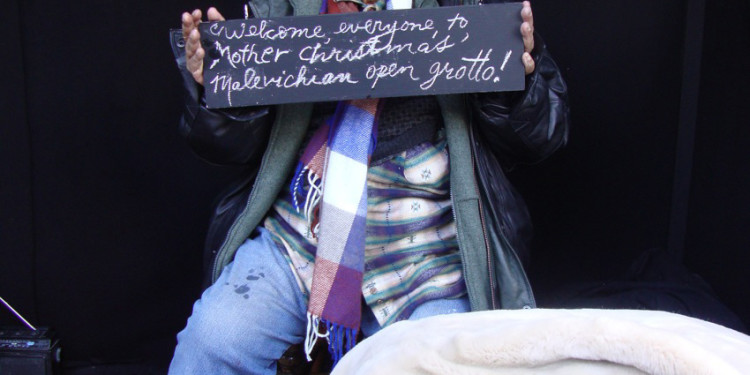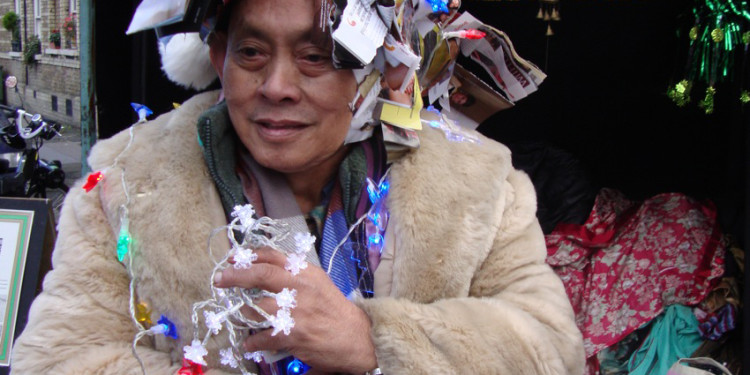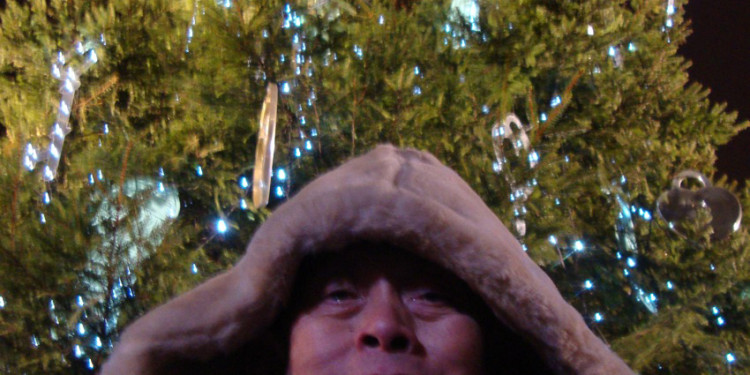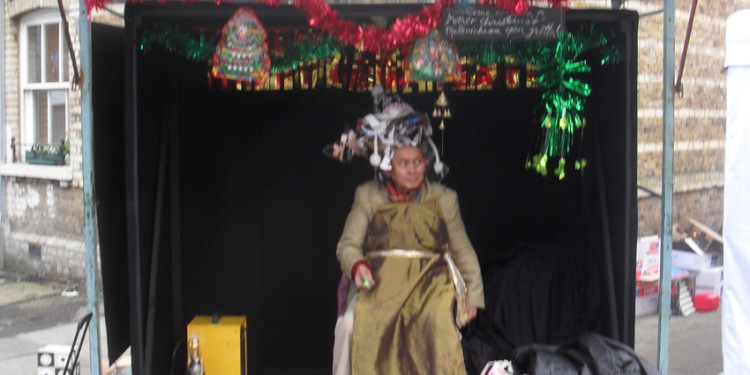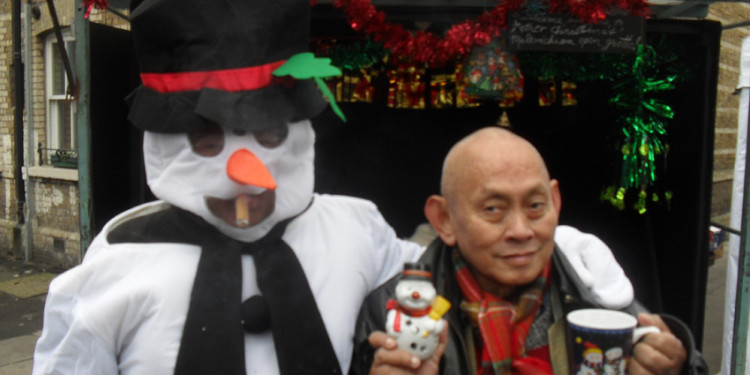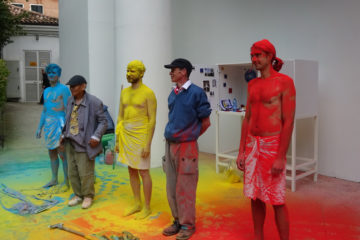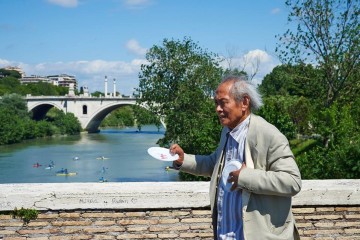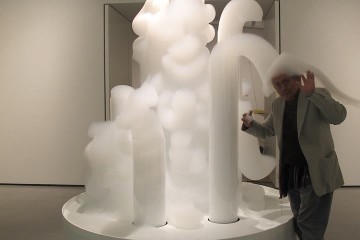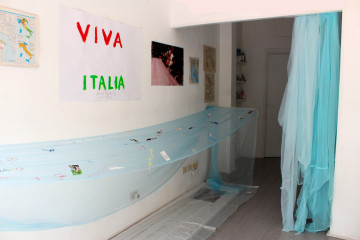MOTHER CHRISTMAS CAMES TO TOWN
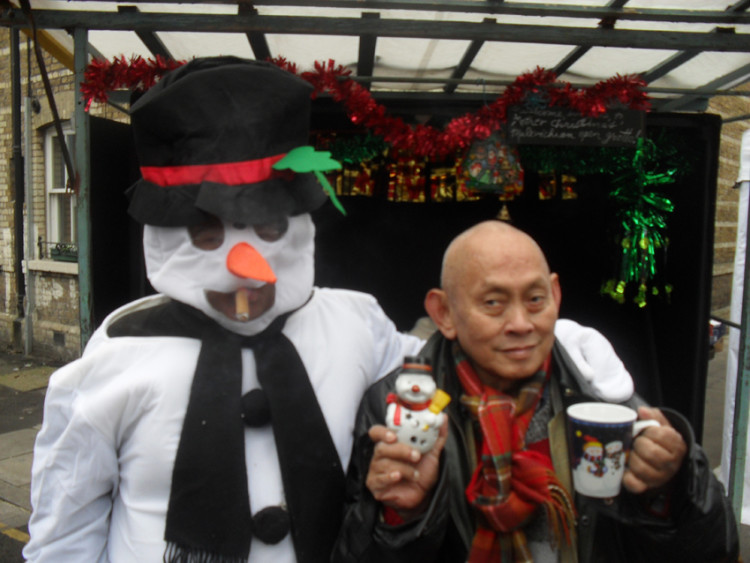
A Yuletide Pantomime by David Medalla
Yesterday, Saturday, the 2nd of January 2010, I went for tea in the home of Hermine Demoriane and Hugo Williams at Angel in Islington, London. Hermine and Hugo are old friends of mine. Hugo, an eminent poet, won the T.S. Eliot Poetry Award, one of Englands most distinguished literary awards. Hermine is a French chanteuse and the chatelaine of the Chateau de Sacy, a vibrant contemporary art centre in Picardie, France. While drinking tea and eating mince pies, we three friends conversed on a variety of subjects : words; neologisms; Teodoro Maler currently sailing in his yacht across to Atlanic Ocean on his way to Argentina; the handsome catalogue of the Vantongerloo exhibition which Guy Brett curated at the Reina Sofia Museum in Madrid, Spain; Adam Nankervis´coming artist´s residency at the Chateau de Sacy during summer of this year (2010); prints by Giorgio de Chirico; a portrait-drawing of Hermine´s mother made by the Belgian artist Paul Delvaux; the travel writings of Hugo Williams (Egypt, Tahiti, Latin America); the memorial event to musician Paul Burwell which Anne Bean (recently returned from Iraq) is organising; Derek Jarman´s film ´Jubilee´which German film-maker Fritz Stolberg saw and admired recently; tight-rope walking (Hermine is a tight-rope walker who invited Philippe Petit to do a tight-rope walking event at the Serpentine in London many years ago; Philippe Petit was the daring Frenchman who walked on a tightrope between the two tall towers of the World Trade Center in New York in 1974); and a host of other subjects during our convivial conversations over the course of nearly four hours.
Both Hermine and Hugo came on separate days to the tail-ends of the two inter-linked performances entitled “Mother Christmas Comes To Town: A Yuletide Pantomime” which I gave on Friday, December 4 and Friday, December 11, 2009, at the Fordham Art Gallery, directed by Man Somerlinck, on stall 31, at the White Cross Street Market in London EC1.
The traditional English pantomime is a theatrical spectacle created for children which takes place during Christmas time. I saw my first English pantomime in 1976, sixteen years after I first arrived in London. The British broadcaster and writer Bamber Gascoigne treated his children and me at Christmas time to a pantomime at a theatre in Richmond, Surrey. The pantomime was a rollicking version of ´Cinderella´. I was struck by the fact that the leading male role – that of Prince Charming – was played by a female actress while the roles of Cinderella´s two step-sisters were played by a pair of two male actors. In fact, in traditional English pantomimes the leading male roles are played by female actresses and the female roles (especially the comic ones) are played by male actors. I thought the traditional English pantomime is the obvert way English people celebrate androgyny.
When English artist David Goldenberg introduced me to Man Somerlinck and the latter invited me to show in his mobile art gallery, the Fordham, on White Cross Street Market, I told Man that, as the month of December will be around Christmas time, I would like to put on a yuletide pantomime. I explained to Man that I was going to call my pantomime ´Mother Christmas Comes To Town´because I imagined Father Christmas to have changed gender – from male to female. To announce the two inter-linked performances I made two drawings on paper: one of a young Mother Christmas with abundant flocks of hair and another of a slightly older Mother Christmas with dishevelled hair. I plan to make other drawings of Mother Christmas progressively getting older for future yuletide pantomimes until years from now she turns into Grandmother Christmas. My two original drawings were made into a limited edition of 500 xerox prints each on green and red paper (red and green being the traditional colours associated with Christmas in northern countries) and were sold for one pound English sterling per print with the other print thrown in for free, to cover some of the costs of the performances. ´BUY ONE, GET ONE FREE´was the slogan I appropriated from stores and supermarkets. The prints were offered for sale as a bargain.
On the morning of Friday, the 4th of December 2009, while walkng from Old Street tube station to White Cross Street Market, Adam Nankervis found a fashion magazine. Adam´s expert hands transformed the magazine´s glossy colour pages into a carnivalesque hat for me to wear as Mother Christmas. Using bunting and tinsel and an assortment of objects, Man Somerlinck, Marko Stepanov and Adam Nankervis instantly converted the wooden stall (the Fordham Art Gallery) into the mobile home of Mother Christmas.
My performance started at noon. I began by asking the audience to tell me a Christmas present they received as a child. The answers were varied. Matthias Spiess, a Swiss artist currently living in London, said he received a toy train from his parents. Eleana Louka, an artist from Cyprus, said she also received a toy train at Christmas. Feline, a young writer who came with German artist and singer Mika Neu from Hamburg, Germany, said she received a book of fairytales from her parents. Orso Tosco, a young poet and dramatist from Italy, said he also received a book from his father: the collected writings of the Marquis de Sade.
A ´core idea´of my yuletide pantomime is to transform the varied collection of reminiscences of the audience (their individual memories of the gifts and presents they received as children at Christmas) into the evolving actions of the pantomime. Thus, on the second performance, Cecilia Graevesen, an artist and curator from Copenhagen, recalled that her father transformed his scarf into a finger puppet which he gave to Cecilia as a child. I invited the audience to transform their scarves into finger puppets and together we improvised a dance with our finger puppets. Ben Turner, a young English photographer, remembered a Christmas present of a skateboard from his dad. I invited the audience to imagine they were riding a skateboard; their scraping feet movements (including instances of ´falling´from their imaginary skateboards) were ´choreographed´into the choric dance of the finger puppets.
During the course of the two performances of my yuletide pantomime, I created in my head ´Mnemonic Archives´ of the memories contributed by various individuals. Those memories I will transform into actions which will be part of an on-going continuously evolving yuletide pantomime. For example, the memories of toy trains by Matthias and Ileana will be converted into an imaginary ´living´ train which the audience will enact complete with puffing sounds, the sounds of wheels moving, and the sounds of train whistles.
Adam Nankervis remembered the gift of a typewriter he received as a boy in Melbourne, Australia, at Christmas. I thought of asking the audience in the future to mime the actions of typing on imaginary typewriters while a chorus recites passages from the writings of Marquis de Sade; thus, combining the different gifts Adam and Orso received. Structurally, my yuletide pantomime is a development, an evolution from the participatory kinetic structures I created in the 1960 and 1970s such as ´The Buddha Ballet´(which I created with John Dugger on Parliament Hill, Hampstead Heath, London, in 1968), ´A Stitch in Time´, ´Porcelain Wedding´, ´Alchemical Wedding´, and ´Down With the Slave Trade!´ (versions of which I created in Africa, India, the USA, England and Europe).
I consider my yuletide pantomime a Hymn to Innocence. Innocence is the ineffable state of pure grace which we lose when we cease to be chlldren and become adults. Through art, through recollections of the gifts we received as children at Christmas, we can experience in our imagination some poignant memories of innocence. As children we look forward with antipation to the gifts we will receive at Christmas from our friends, siblings, relatives and/or friends and even, sometimes, from kind strangers. We receive our Christmas presents in a state of innocence and grace, even though, some times, we are disappointed with the forms such presents take.
Poet Hugo Williams said to me that this Christmas he observed the joy on his grand-daughter´s face when she unwrapped the present he gave her: a bicycle. Hugo recalled the joy he experienced as a boy when he unwrapped the gift his parents gave him one Christmas: a bicycle.
During my yuletide pantomime ´MOTHER CHRISTMAS COMES TO TOWN´, Marko Stepanov came as a Snowman smoking a cigar which nearly set on fire his ´carrot´nose. Luckily (while the audience were shouting ´In front of you: your Nose! – similar to when the audience at an English pantomime shout ´Behind you! Behind you!´ to the baffled heroine or hero on stage), with lightning spped, Adam Nankervis pt out the fire on the tip of the Snowman´s Carrot-Nose.
During my yuletide pantomime, Chris McHugo made a traditional Berber drink in copper vessels he brought from the Atlas Mountains in Morocco where Chris has a beautiful hotel. The hot Berber drink way a wonderful way to combat the wintry cold.
The Fordham Art Gallery is a very original idea of bringing contemporary experimental art to the public. Man Somerlinck has been running his mobile art gallery the last two years. Each month is divided into individual shows by three artists. Documentation is in the form of a beautiful poster. The White Cross Street is a lively market teeming with different restaurants and cafes serviving a wide variety of food from all over the world. The market is a living example of the benign face of globalisation. The people who came to my yuletide pantomime were from different ethnic backgrounds and nationalities.
MOTHER CHRISTMAS CAME TO TOWN AND WAS IMMENSELY PLEASED TO PERFORM AT THE WHITE CROSS STREET AND THANKING ALL WHO PARTICIPATED IN THE YULETIDE PANTOMIME, MOTHER CHRISTMAS (LADEN WITH THE MEMORIES OF CHRISTMAS GIFTS GIVEN TO HER BY THE AUDIENCE) LEFT, SMILING, TO GREET WITH JOY THE NEW YEAR 2010.
A VERY HAPPY, PEACEFUL, PROSPEROUS AND CREATIVE NEW YEAR TO EVERY ONE!
David Medalla
Photos by Adam Nankervis, London 2009
